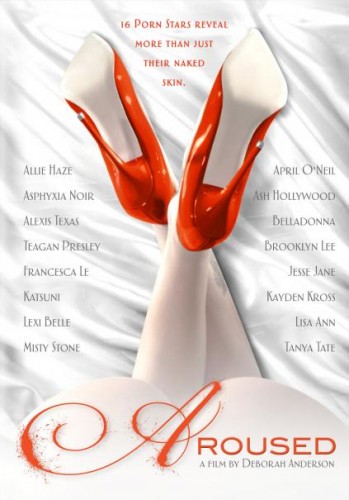Home Video Hovel: Aroused, by James T. Sheridan
“This is not a story about pornography. This is a story about women,” announces director Deborah Anderson at the beginning of her documentary about sixteen women in the adult film industry. She begins to examine the conflict between innate sensuality and the cultural obsession with sexuality through a series of interviews and photo shoots with these women. Her opening sequence resembles a music video with stylized black and white glimpses of mysterious women in sunglasses, riding in an elegant car on sun-dappled streets, with palm trees rising and birds flying off in the distance.
Simultaneously creating an art book and a documentary, Anderson examines the religious backgrounds of the women, their supportive or judgmental families, their childhoods and young adult years, as well as the effect that the porn life has had on them. The interviews blend together, shifting from one woman to another every two minutes or so. Despite the inclusion of quotations from Erica Jong, Marlene Dietrich, Joan of Arc, and Eleanor Roosevelt, it is the women themselves who offer the most revelatory and contradictory truths. “You have to keep this look to make money,” admits one woman about the cultivation of an image, and another boldly declares, “I want to rise to the top.”
The film’s most surprising window into the industry comes from Agent Fran Amidor. A conflicted figure, Amidor sits with Anderson and explains the trajectory of a porn star who hopes to achieve longevity in such a youth-oriented business. She points out how the women can “lose a sense of themselves” in the industry and hints at the difficulty that can arise in future relationships and in their own families. Amidor remarks that it is not uncommon for a porn star to earn and spend more than $250,000 in her first three years. One woman announces, “I found my stability in porn,” and another remarks that porn was better for her than college would have been. Meanwhile, the men behind the camera and the industry are never seen and rarely mentioned.
At times, Anderson’s use of extreme close-ups, floating camera movement, and shifting focus can be distracting. Some of her questions clumsily hint at the pain behind the smiles; at one point, she asks Amidor, “Is there a lot of people in the industry whacked out?” The women seem grateful for Anderson’s curiosity and respect. At times, Anderson eagerly engages in conversations, offering an answer from her own perspective instead of that of her interviewee. Eventually, Anderson decides to withdraw herself from the documentary, and the final twenty minutes consists of moments from the photo shoot cut with fragments of interviews from the various women. Anderson occasionally cuts away to montages from the women’s industry scenes that offer a stark contrast to the modeling shoot.
These women are humanized through Anderson’s questions, her camera, and her desire to tell their collective stories. However, the reality of these women as objects to their male viewers remains unexplored, as do the psychological, physical, and emotional long-term effects of the industry on them. The celebratory closing credits show the women interacting with fans at an Adult Film Expo, with eager men queuing up to take a picture with them on their cell phones. Yet, for me, an undercurrent of sadness permeates the documentary as a whole: male power, rampant STD’s, no health insurance, the loss of self to the camera, and the uncertainty of the far-reaching consequences. In its slender running time of sixty-nine minutes, Aroused begins a conversation that it unfortunately cannot explore in greater depth.




























